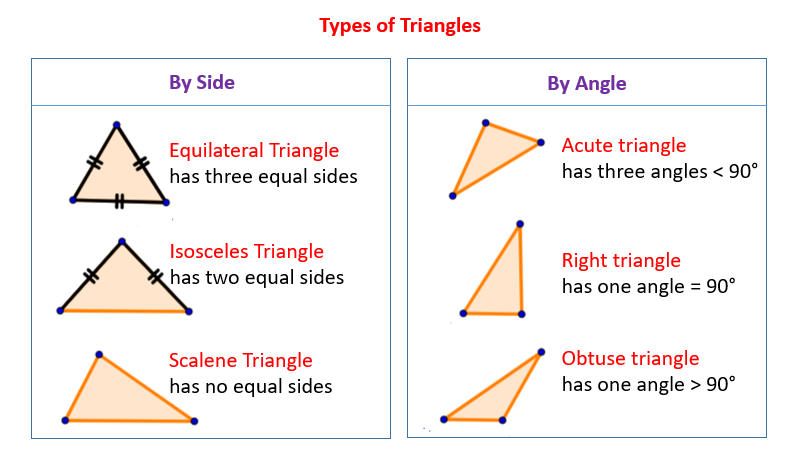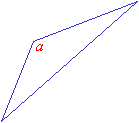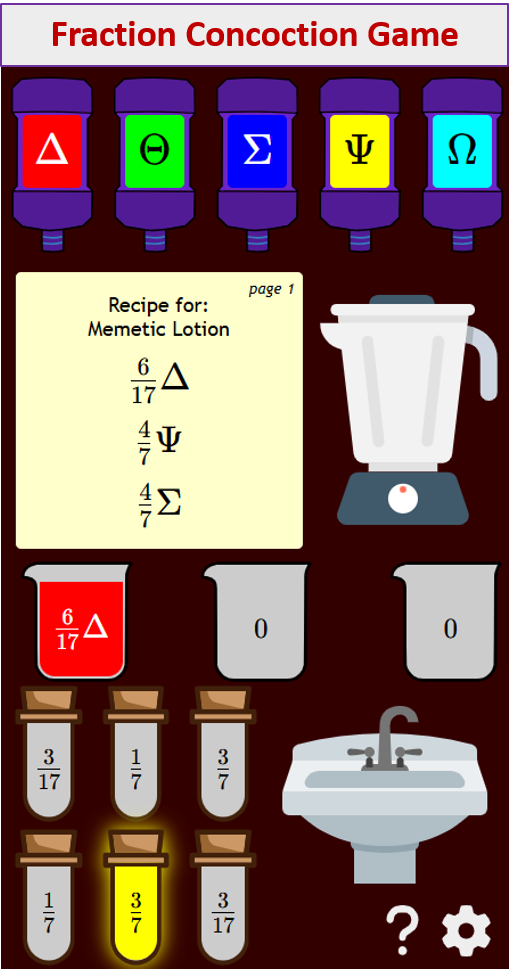Right Triangles, Acute Triangles and Obtuse Triangles
Related Pages
Types Of Triangles
Classifying Triangles
Classify Triangles by length of sides
Special Right Triangles
Area Of Triangles
More Geometry Lessons
In these lessons, we will learn how to classify triangles by their angles: Right Triangles, Acute Triangles, Obtuse Triangles.
We can also classify triangles by the lengths of their sides: Equilateral Triangles, Isosceles Triangles, Scalene Triangles.
Triangles are three-sided polygons with three vertices and three angles. The sum of the interior angles of any triangle is always 180 degrees. Triangles are typically classified in two main ways: by their side lengths and by their angle measures.
The following diagrams show the types of triangle based on sides and angles. Scroll down the page for more examples of the types of triangles.

Geometry Worksheets
Practice your Geometry with the following worksheets.
Printable & Online Geometry Worksheets
I. Types of Triangles Based on Angle Measures
This classification depends on the measure of the largest angle within the triangle.
Right Triangles
Exactly one of its interior angles is a right angle (i.e. 90°). The other two angles are acute angles.
The side opposite the right angle is always the triangle’s longest side. It is called the hypotenuse of the triangle. The other two sides are called the legs.

Right triangles are used in many branches of mathematics. For example, in trigonometry and also in the Pythagorean Theorem. The lengths of the sides of a right triangle are related by the Pythagorean Theorem. There are also special right triangles where the sides are of certain fixed ratios.
Types of Right Triangles
- Isosceles Right Triangle:
A right triangle can be isosceles if the two legs are equal in length. A right isosceles triangle will have a 90º angle and two 45º angles. - Scalene Right Triangle:
A right triangle with all sides of different lengths.
The angles are 90° and two acute angles (e.g., 30° and 60°).
A right triangle can not be equilateral because the hypotenuse must always be longer than the legs.
Trigonometric Ratios:
Right triangles are the foundation of trigonometry.
The trigonometric ratios (sine, cosine, tangent) are defined based on the relationships between the sides and angles of a right triangle.
sine = opposite/hypotenuse
cosine = adjacent/hypotenuse
tangent = opposite/adjacent
Acute Triangles
An acute triangle is a triangle whose angles are all acute (i.e. less than 90°).
In the acute triangle shown below, a, b and c are all acute angles.

An equilateral triangle is always an acute triangle since all its angles are 60° which are acute angles.
Obtuse Triangles
An obtuse triangle has one obtuse angle (i.e. greater than 90°). The other two angles must be acute. The longest side is always opposite the obtuse angle. In the obtuse triangle shown below, a is the obtuse angle.

Since the sum of all the angles in a triangle is 180º, only one angle in the triangle can be an obtuse angle, the other two angles must be acute angles.
II. Types of Triangles Based on Side Lengths
This classification depends on how many sides of the triangle are equal in length.
Equilateral Triangle
All three sides are equal in length.
All three angles are also equal.
Since the sum of angles is 180°, each angle in an equilateral triangle is 60°.
It is also known as an equiangular triangle.
Isosceles Triangle
At least two sides are equal in length. (Some definitions say exactly two, but the “at least two” definition means an equilateral triangle is a special case of an isosceles triangle).
The angles opposite the two equal sides (called base angles) are also equal in measure.
The third side is called the base.
Scalene Triangle
All three sides have different lengths.
All three angles are also different in measure.
The largest angle is opposite the longest side, and the smallest angle is opposite the shortest side (Angle-Side Relationship).
Videos
Discover the six ways to classify triangles, both based on the measure of their side lengths and by the measure of their angles
The differences between the acute triangle, the right triangle and the obtuse triangle
How to classify triangles - acute, obtuse, right?
The Three Types of Triangles (Based on What Kinds of Angles They Have)
Try out our new and fun Fraction Concoction Game.
Add and subtract fractions to make exciting fraction concoctions following a recipe. There are four levels of difficulty: Easy, medium, hard and insane. Practice the basics of fraction addition and subtraction or challenge yourself with the insane level.

We welcome your feedback, comments and questions about this site or page. Please submit your feedback or enquiries via our Feedback page.